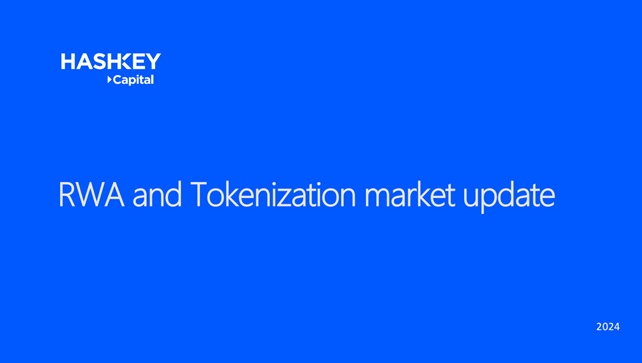【DMI X KLG X HashKey】"高思在云" RWA Webinar Minutes
DMI's "高思在云" series webinar, themed "Current Global Trends of Fixed Income and Bonds Tokenization" was successfully held on the afternoon of September 26, 2024.
This event invited K&L Gates partner Jay Lee and HashKey Capital partner Jupiter Zheng who provided in-depth analyses of RWA and tokenization market, global STO regulatory trends, the key legal and regulatory considerations for tokenization of fixed Income products in Hong Kong and case study of tokenized debt securities in Hong Kong.
This webinar would like to provide insights to conventional market players in better understanding the opportunities and risks of this evolving market and to offer hands-on advices.
Minutes
K&L Gates Jay Lee: Global Trends of Fixed Income and Bonds Tokenization

As crypto market growing, more traditional financial institutions joining the group.
For example, Goldman Sachs Digital Asset Platform (GS DAP) achieved 15 basis points in savings for its €100M digital bond issuance, resulting in €150K of added return passed onto Union Investment as the sole buyer.
While Broadridge's Distributed Ledger Repo (DLR) is saving sell-side clients like Societe Generale $1 million per 100,000 repo transactions.
Moreover, market value of tokenized treasuries is soaring.
Talking about charms of tokenized treasuries, tokenized treasuries are specifically interesting for people who are already holding stablecoins but looking for 'higher yields' ; or taking tokenized treasuries as investment hedge, which provides a sort of 'shock absorber' in case the stock market collapses.
Besides treasuries, non-financial corporate and quasi sovereign debt, real estate funds, private equity/venture capital, securities financing and collateral, trade finance could all be tokenized, and potentially embedded trillions of value. Boston Consulting Group expects $16 trillion by 2030 on real world assets tokenization.
Considering global key regulatory frameworks and trends, we can see:
- U.S.A. using the existing securities laws: Securities Act of 1933 and Exchange Act of 1934;
- Japan enacted STO related laws;
- EU enacted the Markets in crypto-assets Regulation (MiCA), consider security tokens-crypto assets as 'financial instruments' are subject to existing regulations;
- UK using the existing Financial Services and Markets Act and with respect to security tokens, the Regulated Activities Order; FCA's Guidance on crypto assets; Security tokens–crypto assets that grant holders right and obligations similar to traditional financial instruments;
- Constantly evolving regulatory landscape. STOs are increasingly subject to existing securities regulations across jurisdictions, including the U.S.A., the UK and Hong Kong. STOs are not uniformly regulated at an international level, though in most cases, a technology-neutral approach is taken;
- Hong Kong 'Same activity, same risk, same regulation' approach.
In Hong Kong, here are the key legal and regulatory considerations for tokenization of fixed income products:
- Key laws: AMLO (Non-security type virtual assets) and SFO (Security type virtual assets);
- Key government authorities and regulators: FSTB, SFC, HKMA and Insurance Authority;
- Virtual asset trading platforms: SFC New Licensing Regime for VATPs (effective since 1 June 2023), SFC Guidelines for Virtual Asset Trading Platform Operators ('VATP Guidelines'), SFC Licensing Handbook for Virtual Asset Trading Platform Operators;
- Key regulatory frameworks – Two SFC circulars announced on 2 November 2023: Circular on intermediaries engaging in tokenized securities related activities ('SFC Tokenized Securities Intermediaries Circular'); Circular on tokenization of SFC-authorized investment products (SFC Authorized Investment Products Tokenization Circular); SFC TSI Circular supersedes its previous statement on security token offerings announced in March 2019 ('SFC Statement').
Japan STO frameworks and markets:
- Amendment to Financial Instruments and Exchange Act ('FIEA') – May 2020: clarification of legal status of security token; regulations of intermediaries on sales and solicitation and of issuers on initial and ongoing disclosure;
- Amendment to the Act on Strengthening Industrial Competitiveness – August 2021: notice of assignment of receivable using a computer system approved by METI satisfies the 3rd party defense requirement;
- Future initiatives to develop secondary markets.
HashKey Capital Jupiter Zheng: RWA and Tokenization market update

Real-world assets ('RWAs') refer to tokenized, on-chain versions of tangible and intangible non-blockchain assets, e.g., currencies, real estate, bonds, commodities, etc. Total on-chain RWAs are at all-time highs at US$12B+ (excluding the US$175B+ stablecoin market).
In general, tokenization is the process of issuing a digital, unique, and anonymous representation of a real thing.
The benefits of Web3 tokenization for financial institutions include the following:
- Settlement efficiency: Blockchain transactions settle nearly instantaneously, and can be structured such that the exchange of an asset is conditional on payment, reducing the risk of settlement failure;
- Programmability: Tokenized assets can be integrated into software applications to allow for increased functionality. This may include, for example, transfers conditional on off-chain information, like compliance approvals, or the use of tokens as collateral in decentralized lending platforms;
- Accessibility: Like the internet itself, blockchains are not limited by national borders. Tokenizing assets could therefore bring access to the world's best capital markets to investors in a wider range of countries. Blockchains may also open access to new asset types through fractionalization;
- Lower costs: By increasing automation and reducing the role of intermediaries, tokenizing assets may reduce cost for issuers through lower underwriting fees and lower interest rates.
Global Trends
- Increased Regulatory Scrutiny: Various jurisdictions are enhancing scrutiny of tokenization practices, particularly regarding compliance with anti-money laundering (AML) and know your customer (KYC) regulations. (European Union, the Markets in Crypto-Assets (MiCA) regulation);
- Guidelines from Regulatory Bodies: Organizations like the Financial Action Task Force (FATF) are updating guidelines for virtual assets, emphasizing the need for clear identification and tracking of token transactions. (The FATF updated its guidance in 2022);
- Securities Regulations: Many countries are clarifying how tokenized assets fit within existing securities laws. For instance, the U.S. Securities and Exchange Commission (SEC) has been actively categorizing certain tokens as securities, requiring issuers to comply with registration and reporting obligations. (The SEC's actions against companies like Ripple Labs);
- Consumer Protection Measures: Regulators are focusing on consumer protection, proposing measures to ensure transparency about the risks associated with tokenized assets. (the UK, the Financial Conduct Authority (FCA) );
- Global Cooperation: There is a trend toward international collaboration among regulators to create cohesive frameworks that address the cross-border nature of tokenized assets. (The G20's discussions);
- Sandbox Initiatives: Some jurisdictions are implementing regulatory sandboxes to allow for innovation in tokenization while ensuring compliance with regulatory standards. (The Monetary Authority of Singapore (MAS) ).
Talking about stablecoin in HK, the Financial Services and the Treasury Bureau (FSTB) and the Hong Kong Monetary Authority jointly published the consultation conclusions on the legislative proposal to implement a regulatory regime for fiat-referenced stablecoin (FRS) issuers in Hong Kong. The conclusions indicate that a draft bill will be introduced later in the year.
While talking about tokenization of SFC-authorised products and securities. The Securities and Futures Commission ('SFC') issued two circulars on 2 November 2023 respectively concerning: (i) the requirements and considerations of primary dealing of tokenized SFC-authorised products to the public ('Tokenized Products Circular') and (ii) guidance to intermediaries engaging in tokenized securitiesrelated activities ('Tokenized Securities Circular') (collectively, the 'Circulars').
As required, tokenization arrangement product providers should:
- Remain and be ultimately responsible for the management and operational soundness of the tokenization arrangement adopted and record keeping of ownership, regardless of any outsourcing arrangement;
- Ensure that proper records of token holders' ownership interests in the product are maintained and the tokenization arrangement is operationally compatible with service providers involved;
- Have appropriate measures in place to manage and mitigate cybersecurity risks, data privacy, system outages and recovery, and maintain a comprehensive and robust business continuity plan;
- Not use public-permissionless blockchain networks without additional and proper controls (e.g. Product Providers to impose additional control by using a permissioned token);
- Confirm and, upon SFC's request, demonstrate to the SFC's satisfaction the management and operational soundness of the tokenization arrangement, record keeping of ownership and the integrity of the smart contracts;
- Upon SFC's request, obtain third party audit or verification on the management and operational soundness of the tokenization arrangement, record keeping of ownership and integrity of the smart contracts;
- Upon SFC's request, obtain satisfactory legal opinion to support its application.
Lastly, introduced practical cases of RWA such as BlackRock BUIDL, Ondo Finance, and Tether.
Q&A
Q: How do the fed rate cut decisions and election results impact the crypto currency market? Especially stable coins linked to digital bonds.
Jay Lee: Election result is quite difficult to predict, but back into the rate cut, once interest rates keeps going down, issuers may want to do refinancing and come back to the bonds market, while many of them can try to be tokenized, so there will be more activities expect to see.
Q: In what ways does STO help issuers and secondary market traders reduce costs?
Jupiter Zheng: STO will get liquidity using an on-chain mechanism. Issuing from private credit sectors is considered low cost, especially when you want to settle this kind of new asset on chain will be very convenience. They'll have automatic bookkeeping on-chain. You can download it from blockchain directly. And it is transparent to everyone, everyone can refer to that and save a lot of fees. So there will be many benefits, as I mentioned before, I think the cost saving is one of the points that should consider.

Record
For a full record of the conference, please scan the QR code below to watch:

The conference was synchronously broadcasted through the dual platforms of ZOOM and Tencent Meeting, and attracted the attention of many financial institutions such as securities, banks, insurance, funds and asset management, with nearly 100 registrations and attendances.
DMI's "高思在云" series are the webinar launched by CSCI, which will invite relevant experts from time to time to discuss the latest market trends with DMI users, welcome to stay focused!
DMI provides you with a global overview of the Crypto market. You can access daily price volatility of major coins, regulatory trends, new issues, and institutional innovations through DMI app or DMI terminal.
